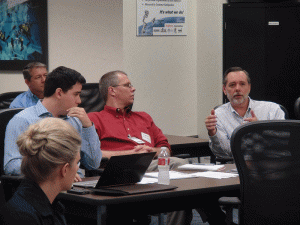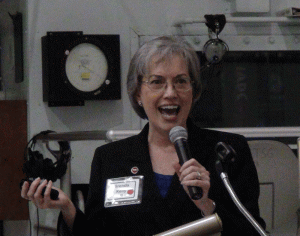Raising the bar for global safety, competency

IADC aims for step-change with worldwide competency guidelines for rig-based positions
By Linda Hsieh, managing editor
IADC has kicked off an ambitious project to develop worldwide competency guidelines for virtually all rig positions, with a priority on safety-critical positions with well control responsibilities. The guidelines, to be built upon IADC’s Knowledge, Skills and Abilities (KSA) templates, aim to provide tools for confirming the proficiency levels of the drilling work force, develop competence levels for new entrants and help ensure that a globally accepted level of competency exists in the drilling industry when recruiting.
“IADC is the global leader in developing competency and training programs for the drilling industry,” said 2012 IADC chairman Dan Rabun, chairman, president and CEO of Ensco. “This ambitious expansion of IADC’s KSAs represents a step-change for safety and competency in our industry.”
“The revamped KSAs will provide the industry with a benchmark for globally consistent drilling position requirements, as well as recommend means for effectively evaluating personnel,” remarked Stephen Colville, IADC president and CEO. “It will also help personnel identify areas where further training and development are needed and point them to resources to help close those gaps.”
During the first of three planned phases for the project, IADC will undertake a worldwide modeling of similar competency systems being used in other industries and even by governments, then determine if there is an existing system structure that could be adapted for the drilling industry. “We’re not looking necessarily to make a completely new mousetrap but take what’s good out there and modify it to exactly fit what this industry needs,” said Mark Denkowski, IADC VP of accreditation and certification.

Both a steering committee and a review panel with representatives from IADC member companies will be established to keep the project on track. Further, Petrofac Training Services (PTS) has been contracted to assist the project by conducting the modeling effort on a global basis, from Australia to South Africa to Singapore to the UK. PTS also will conduct a series of surveys of drilling contractors and operators around the world to collect and collate data for completing the project.
Mr Denkowski said he expects the survey to result in approximately 60 rig-based positions but notes that the real challenge will be around how specific positions are designated. “A driller is a driller, and an AD is an AD. But for toolpushers, for example, some companies call them superintendents, some call them rig managers, and some call them drilling foremen or senior drilling foremen. Whatever they call the positions, we have to come up with a common nomenclature for activities so that companies can map their own employees to the right competency guidelines for their roles,” he said.
Approximately 10 to 15 positions will be targeted in Phase One, including safety-critical positions with well control responsibilities such as driller, toolpusher and subsea engineer. “Phase One is by far the largest because we’re going to set the template for all three phases. It’s where we’re building the model for how we will develop competency guidelines for all these rig positions,” Mr Denkowski said.
Among the key considerations is how to account for the different operating environments that rig crews work within – such as whether the employee will be going to a land or offshore rig. If it’s a land rig, will it be a conventional rig or an advanced-technology automated rig? If offshore, will it be a jackup, semisubmersible or drillship and in what water depths will it be operating? “Each of these drillers will look slightly different than another driller, so we have to decide how many levels of driller are needed, or how many levels of AD for any given position,” Mr Denkowski said.
Operational differences for rigs operating in different parts of the world is another critical element that must be considered. These differences may be reflected by incorporating regional clarifications in the guidelines, although the overall aim is still to keep the KSAs globally applicable across all markets.
It’s also important to note that IADC is not developing a competency assessment program but rather competency guidelines, he added. Driven by requests from drilling contractors and operators alike, the project aims to define globally industry-accepted levels of competency for rig positions that can be applied worldwide and across a spectrum of companies. “We want this whole development process to be very transparent as it evolves and give everyone a chance to comment. We want to get to the end game with everybody on the same page,” he said.

A workshop was held at the NASA Hi-Con Training Center on 21 February with the participation of 11 drilling contractor companies and nine operator companies. Through several breakout sessions, the 45-plus attendees provided comments and information that are being used to guide the project’s scope and define the deliverables. Further, a website is being set up that will allow potential end users to provide suggestions as the project progresses. “But even after the guidelines are out, we will keep the website running to collect continuous comment for updates. We want to keep the guidelines live and current and always making it better,” Mr Denkowski said.
IADC expects to wrap up Phase One by the end of 2012 or early 2013. Phases Two and Three will target the remainder of rig-based positions such as mechanic, electrician, roustabout, floorhand and derrickman. “For the third phase, we’re also considering looking at non-traditional rig-based positions like masters, captains, mud engineers and mud loggers,” he added.
Once released, the new guidelines will be open access, just like the original IADC KSAs published in 2001. Those original KSA templates for 12 rig positions, as well as a general KSA focused on health, safety and environmental issues, are available on the IADC website.




